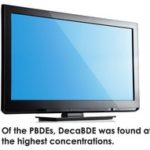The Chemicals
Something’s In The Air
What Does It Mean To Be Breathing Toxic Flame Retardants?
The flame retardants used in products in our homes can cause cancer and harm to the nervous system. As researchers conduct more extensive studies into how flame retardants are affecting us, they are making some startling new discoveries:
- Studies of children exposed before birth to the neurotoxic PBDEs are finding that kids with higher levels of PBDEs have lower IQs: about a 5 point deficit is associated with a tenfold higher PBDE level[1].
- Tests of flame retardants in the dust in 40 California child care centers found widespread exposure to cancer-causing flame retardants. Researchers estimated that more than 50% of child care centers had levels of cancer-causing TDCPP experts consider unacceptable[2].
This new information on our daily exposure to flame retardants adds to these growing reasons for concern: flame retardants linked to serious health problems are escaping from products and getting into the very air we breathe.
“It’s shocking to find out toxic flame retardants are in the air I am breathing. I’ve worked really hard to minimize my family’s exposure to toxic chemicals. It’s frustrating to learn companies are still putting cancer-causing flame retardants in products.”
– Liz Zimmerly, study participant
The Toxic Flame Retardants In Our Air
PBDEs
 We measured levels of 11 polybrominated diphenyl ethers, or PBDEs. These flame retardants were widely used in home furniture, children’s products, and electronics until their phaseout, which began in 2004. They have been detected in housedust, sediment, breast milk, fish, and wildlife including orcas[1]. They are known to be toxic to the nervous system and to affect thryoid function, and recent studies have shown impacts at typical U.S. levels of exposure[2-4].
We measured levels of 11 polybrominated diphenyl ethers, or PBDEs. These flame retardants were widely used in home furniture, children’s products, and electronics until their phaseout, which began in 2004. They have been detected in housedust, sediment, breast milk, fish, and wildlife including orcas[1]. They are known to be toxic to the nervous system and to affect thryoid function, and recent studies have shown impacts at typical U.S. levels of exposure[2-4].
Tris Compounds
We measured levels of three Tris compounds, or chlorinated organophosphates: TDCPP, TCEP, and TCPP. All three Tris compounds have seen heavy use in polyurethane foam in residential furniture and children’s products. In addition, TCPP is found in home insulation. TDCPP and TCEP have been designated as cancer-causing by the state of California and may be toxic to the nervous system, and all three compounds have been banned from toys in the European Union beginning December 31, 2015[5, 6].
Firemaster 550 Compounds
We measured levels of two flame retardants present in the Firemaster 550 product, as well as other products: TBB (2-ethylhexyl-2,3,4,5-tetrabromobenzoate) and TBPH (bis(2-ethylhexyl) 3,4,5,6-tetrabromophthalate). Firemaster 550 was introduced by Great Lakes Chemical (now Chemtura) for use in polyurethane foam when the penta form of PBDEs was phased out. Both compounds have been detected in house dust and a metabolite of TBB has been detected in urine of U.S. children and adults[7]. Both compounds have also been categorized by the USEPA as persistent and bioaccumulative, and had developmental effects in laboratory studies.
“It’s interesting to see the results and to learn more about our built environment and what we can do to keep our bodies strong and healthy.”
– Kathy Lambert, King County Councilmember, study participant
Exposure To Toxic Flame Retardants
Recent research is showing that children and adults have flame retardants in their bodies. Researchers are developing new methods to detect less-well studied flame retardants such as those in the Firemaster product, as well as the Tris compounds. These studies are indicating that children have higher levels than adults: a 2014 study of 21 mother-child pairs found young children had an average of nearly five times greater exposure to TDCPP[7]. This study shows that the air we breathe in our homes also presents a significant source of exposure to some flame retardants, especially the Tris compounds.
NEXT: The Solution
Notes
1. Washington State Polybrominated Diphenyl Ether (PBDE) Chemical Action Plan; Washington State Department of Ecology,
Washington State Department of Health,: Olympia, Washington, 2005; http://www.ecy.wa.gov/biblio/0507048.html.
2. Eriksson, P., H Viberg, E Jakobsson, U Örn, and A Fredriksson, A brominated flame retardant, 2,2′,4,4′,5-Pentabromodiphenyl ether: uptake, retention, and induction of neurobehavioral alterations in mice during a critical phase of neonatal brain development. Toxicological Sciences 2002, 67, 98-103.
3. Eskenazi, B.; Chevrier, J.; Rauch, S.; Kogut, K.; Harley, K.; Johnson, C.; Trujillo, C.; Sjödin, A.; Bradman, A., In utero and childhood polybrominated diphenyl ether (PBDE) exposures and neurodevelopment in the CHAMACOS study. Environ Health Perspect 2013, 121, (2), 257-262.
4. Zota, A.; Park, J.-S.; Wang, Y.; Petreas, M.; Zoeller, R.; Woodruff, T., Polybrominated diphenyl ethers, hydroxylated polybrominated diphenyl ethers, and measures of thyroid function in second trimester pregnant women in California. Environ Sci Technol 2011, 45, 7896-7905.
5. A chemical listed effective October 28, 2011 as known to the state of California to cause cancer Tris(1,3-dichloro-2-propyl) phosphate (TDCPP)(CAS No. 13674-87-8); http://oehha.ca.gov/prop65/prop65_list/102811list.html.
6. Directive 2014/79/EU.Appendix C of Annex II to Directive 2009/48/EC of the European parliament and of the Council on safety of toys, as regards TCEP, TCPP, and TDCP. 2014. http://eur-lex.europa.eu/legal-content/EN/TXT/PDF/?uri=OJ:JOL_2014_182_R_0012&from=EN.
7. Butt, C.; Congleton, J.; Hoffman, K.; Fang, M.; Stapleton, H., Metabolites of organophosphate flame retardants and 2-ethylhexyl tetrabromobenzoate in urine from paired mothers and toddlers. Environ Sci Technol 2014, 48, (17), 10432-8.
